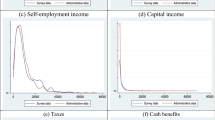Abstract
The purpose of this paper is to raise awareness of missing data when we evaluate income inequality using survey data. If the income data are not missing completely at random, the calculated income inequalities are more likely to be biased, which may lead to inappropriate conclusions and policy recommendations. To handle the missing data on income, a multiple imputation approach is utilized. In particular, we propose an extended approach to correct the possible sample selection bias in the imputation process. A case study using China’s household survey suggests that extended imputation corrects for biases effectively in the calculation of Gini coefficients and results in gains in efficiency as well.
Similar content being viewed by others
References
Abdelkrim, A., Duclos, J.-Y.: DASP: distributive analysis Stata package. PEP, World Bank, UNDP and University Laval
Cornia, G. A., Court, J.: Inequality, growth and poverty in the era of liberalization and globalization.UNU world institute for development economics research (2001)
Davey, A, Shanahan, M. J., Schafer, J. L.: Correcting for selective nonresponse in the national longitudinal survey of youth using multiple imputation. J. Hum. Resour. 36 (3), 500–519 (2001)
Esteban, J., Ray, D.: Linking conflict to inequality and polarization. Am. Econ. Rev. 101, 1345–1374 (2011)
Fajnzylber, P., Lederman, D., Loayza, N.: Inequality and violent crime. J. Law Econ. 45 (1), 1–40 (2002)
Frick, J. R., Grabka, M. M.: Missing income data in panel surveys: Incidence, imputation and its impact on the income distribution. Discussion papers, p 376 (2004)
He, Y.: Missing data analysis using multiple imputation: Getting to the Heart of the Matter. Circ. Cardiovasc. Qual. Outcomes 3 (1), 98–105 (2010)
Heckman, J. J.: Sample selection bias as a specification error. Econometrica 47 (1), 153–161 (1979)
Honaker, J., King, G.: What to do about missing values in time series cross-section data. Am. J. Polit. Sci. 54 (2), 561–581 (2010)
Horowitz, J. L., Manski, C. F.: Censoring outcomes and regressors due to survey nonresponse: identification and estimation using weights and imputations. J. Econo. 84, 37–58 (1998)
Knight, J., Song, L.: Increasing urban wage inequality in China: Extent, element and evaluation. Econ. Transit. 11 (4), 597–619 (2003)
Liu, H.: The China Health and Nutrition Survey: An important database for poverty and inequality research. J. Econ. Inequal. 6 (4), 373–376 (2008)
Ning, G.: Can educational expansion improve income inequality? Evidences from the CHNS 1997 and 2006 data. Econ. Syst. 34 (4), 397–412 (2010)
Royston, P., Carlin, J. B., White, I. R.: Multiple imputation of missing values: New features for mim. Stata J. 9 (2), 252–264 (2009)
Rubin, D. B.: Multiple imputation in sample surveys — a phenomenological Bayesian approach to nonresponse. in proceedings of the section on survey research methods,American Statistical Association, pp 20–34 (1978)
Rubin, D. B.: Multiple imputation for nonresponse in surveys. Wiley, New York (1987)
Rubin, D. B.: Multiple imputation after 18 + years. J. Am. Stat. Assoc. 91 (434), 473–489 (1996)
Schafer, J. L.: Analysis of incomplete multivariate data.London:Chapman and Hall (1997)
Schenker, N., Raghunathan, T.E., Chiu, P.-L.,Makuc, D.M., Zhang, G., Cohen, A.J.:Multiple imputation of missing income data in the national health interview survey. J. Am. Stat. Assoc. 101(475), 924–933 (2006)
Thorbecke, E., Charumilind, C.: Economic inequality and its socioeconomic impact. World Dev. 30 (9), 1477–1495 (2002)
van Buuren, S., Boshuizen, H. C., Knook, D. L.: Multiple imputation of missing blood pressure covariates in survival analysis. Stat. Med. 18, 681–694 (1999)
Wan, G., Zhang, X.: Rising inequality in China. J. Comp. Econ. 34 (4), 651–653 (2006)
Yu, J., Zhu, G.: How uncertainty is household income in China? Economics Letters 120 (1), 74–78 (2013)
Author information
Authors and Affiliations
Corresponding author
Rights and permissions
About this article
Cite this article
Chen, Y., Fu, D. Measuring income inequality using survey data: the case of China. J Econ Inequal 13, 299–307 (2015). https://doi.org/10.1007/s10888-014-9283-x
Received:
Accepted:
Published:
Issue Date:
DOI: https://doi.org/10.1007/s10888-014-9283-x




